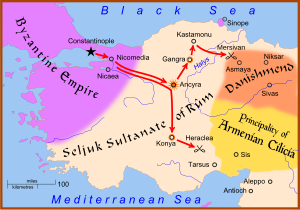Kilij Arslan I
| Kilij Arslan I | |
|---|---|
Suleyman I of Rûm | |
| Religion | Sunni Islam |
Kilij Arslan ibn Suleiman (
Rise to power
After the death of his father,
Following the death of Malik Shah I the individual tribes, the
The Crusades
People's Crusade
The People's Crusade (also called the Peasants' Crusade) army of
The remainder of Peter's crusade composed almost entirely of unarmed civilians was surprised near the village of Civetot by Kilij Arslan's army.
The First Crusade would start a few months later.
First Crusade
Because of this easy first victory he did not consider the main
As result of the stronger invasion, Rum and the Danishmends allied in their attempt to turn back the crusaders. The Crusaders continued to split their forces as they marched across Anatolia. The combined Danishmend and Rum forces planned to ambush the Crusaders near
Kilij Arslan was defeated and settled for harassing the Crusader army with guerilla warfare and hit-and-run tactics. He also destroyed crops and water sources along their route in order to hinder the Crusader Army from collecting supplies, ultimately with little success.
Crusade of 1101

Gazi Gümüshtigin captured Bohemond resulting in a new force of Lombards attempting to rescue him. In their march they took Ankara from Arslan upon the Danishmends. In alliance with Radwan the Atabeg of Aleppo he ambushed this force at the Battle of Mersivan. In 1101 he defeated another Crusader army at Heraclea Cybistra, which had come to assist the fledgling Crusader states in Syria. This was an important victory for the Turks, as it proved that an army of Crusader knights was not invincible. After this victory he moved his capital to Konya and defeated a force led by William II of Nevers who attempted to march upon it as well as the subsequent force a week later.
In 1104 he resumed his war with the Danishmends who were now weakened after the death of Malik Ghazi, demanding half the ransom gained for Bohemond. As a result, Bohemond allied with the Danishmends against Rum and the Byzantines.
War and drowning in river
After the crusades he moved towards the east, taking
Discovery of his burial
In January 2021, archaeologists led by professor Ahmet Tanyıldız from the Dicle University claimed to discover his and his daughter Saide Hatun's grave in Silvan, Diyarbakır.[11] Researchers dug two metres deep across a 35-square-metre area and focused their works on two gravesites in Orta Çeşme Park.[12]
References
- ^ "2nd Anatolian Seljuk sultan's grave found in SE Turkey".
- ^ Savvides, Alexios G. C. (2006). "Qilij Arslān of Rûm (d. 1107)". In The Crusades - An Encyclopedia. p. 998.
- ^ "The first Turkish leader against the Crusaders: Sultan Kilij Arslan I". DergiPark. 2015. p. 67.
- ^ Maalouf 2012, p. 10.
- ^ Brand 1989, p. 3.
- ^ a b Runciman 1969, p. 283.
- ^ Claster 2009, p. 45.
- ^ Runciman, Steven (2005). The First Crusade. New York: Cambridge University Press. p. 95
- ^ Turan 1970, p. 239.
- ^ Runciman 1952, p. 110.
- ^ Gershon, Livia. "Turkish Archaeologists Discover Grave of Sultan Who Defeated Crusaders". 14 January 2021.
- ^ AA, DAILY SABAH WITH (13 January 2021). "Anatolian Seljuk Sultan Kılıç Arslan I's grave found in SE Turkey". Daily Sabah. Retrieved 20 January 2021.
Sources
- Brand, Charles M. (1989). "The Turkish Element in Byzantium, Eleventh-Twelfth Centuries". Dumbarton Oaks Papers. 43: 1–25. JSTOR 1291603.
- Claster, Jill N. (2009). Sacred violence: The European crusades to the Middle East, 1095-1396. University of Toronto Press.
- Maalouf, Amin (2012). Crusades Through Arab Eyes. Saqi Books.
- Runciman, Steven (1952). A History of the Crusades, Volume II: The Kingdom of Jerusalem and the Frankish East. Cambridge: Cambridge University Press.
- Runciman, Steven (1969) [1955]. "The First Crusade: Constantinople to Antioch". In ISBN 0-299-04834-9.
- Turan, Osman (1970). "Anatolia in the period of the Seljuks and the Beyliks". In Holt, Peter Malcolm; Lambton, Ann K. S.; Lewis, Bernard (eds.). The Cambridge History of Islam. Vol. 1A. Cambridge University Press.
